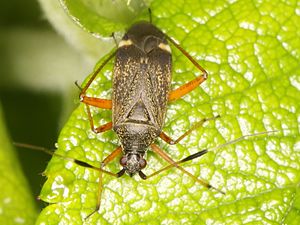Two-lobed soft bug
| Two-lobed soft bug | ||||||||||||
|---|---|---|---|---|---|---|---|---|---|---|---|---|

Two-legged soft bug ( Closterotomus biclavatus ) |
||||||||||||
| Systematics | ||||||||||||
|
||||||||||||
| Scientific name | ||||||||||||
| Closterotomus biclavatus | ||||||||||||
| ( Herrich-Schaeffer , 1835) |
The two-lobe soft Bug ( Closterotomus biclavatus ) is in Central Europe occurring Wanzenart from the family of plant bugs (Miridae).
features
The two-legged soft bug has a brown to brown-black colored top with a short, golden-shiny hair. On the corium of the hemielytres (the partially hardened forewings) there is usually a light spot on the side. The legs are reddish brown, with the rails bearing small black thorns. The dark colored scutellum has a white tip. The antennae are distinctive for the type of bug . The basal segment is black or reddish and thickened. The second antenna segment is thin and reddish at the basal end, while the other half has a black thickening. The third and fourth links, on the other hand, are thin and whitish in color. The bug reaches a body size of 5.9 to 7.7 mm, with the females becoming larger on average than the males.
The bug nymphs also have the black-colored thickening of the second antennae.
distribution and habitat
The type of bug is widespread in Europe. Their distribution area extends to Central Asia. In Germany it is considered rare in the North German lowlands and further north. In the low mountain ranges and in the Alpine region it can be found up to an altitude of about 2000 m.
Way of life
The typical habitat is formed by bushes and trees as well as the herb layer. The bugs feed mainly on plants, but also suckle on aphids . The forage plants of the two-legged soft bug include blueberries ( Vaccinium ), rhododendrons , plants of the Rubus genus and others. The bedbug nymphs are active in the spring, while the full-grown bedbugs can be seen from May to September. The bug species overwinters in the egg stage.
Web links
- Closterotomus biclavatus in Fauna Europaea. Retrieved December 11, 2016
- www.insektenbox.de: Two-legged soft bug
- www.natur-in-nrw.com: Two-lobed soft bug
- www.naturspaziergang.de: Two-legged soft bug
- biolib: Closterotomus biclavatus
literature
- E. Wachmann , A. Melber, J. Deckert: Bugs - Volume 2 . Goecke & Evers, Keltern 2004, ISBN 3-931374-57-2 .
